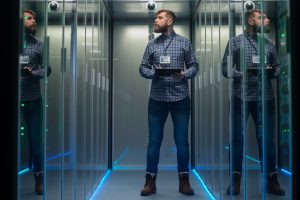According to Market Research Future, the global colocation data center market is expected to grow to approximately $51 billion USD by 2022. A key factor driving that growth is the end user perception that colocation service providers are better equipped to maintain higher levels of business continuity. In order to live up to these expectations, service providers must find innovative ways to drive improved uptime while controlling costs.

Specialized building management and power monitoring digital tools are key assets for helping colocation facilities overcome the challenge of maintaining business continuity. One way colocation service providers can insulate themselves from shifting market conditions is to transition from analog facilities controls to connected, IoT-enabled electrical distribution and HVAC infrastructures. Such investments allow for greater visibility and control, and introduce the possibility of providing an option for remote services support, should that need arise.
Access GUIDEHOUSE INSIGHTS REPORT on Intelligent Building Software
How Colocation Providers Benefit from Digital Tools
Below are some examples of how such digital tools can add value:
- Enhancement of systems uptime – Building management software enables digitized power and HVAC systems to automatically provide real-time updates and alerts to staff desktops and mobile devices. This helps to enable condition-based monitoring. Connected devices, such as smart power meters and building controls, and software-based analytics generated via integrated power management and building management software, help anticipate potential malfunctions in critical electrical and HVAC equipment. The software presents diagnostics and performance data to staff via prioritized alarm notifications and provides recommended actions. Critical maintenance needs are flagged, enabling technicians to minimize or avoid disruptions. Access to such information boosts uptime and assures the physical comfort (through better environmental controls) of onsite staff.
- Control of energy costs/enhanced sustainability – The ability to track energy consumption patterns can reveal pockets of cost-saving opportunities. In situations where occupancy of the colocation facility may be lower than normal, facility-wide remote monitoring of electrical system and loads allows remote operators to make adjustments that result in less energy consumption (e.g., turning off lights when no one is occupying the space). Implementing such measures also helps the colocation provider to track and report CO2 emissions reductions.
- More flexible business continuity planning – Building management digital tools make it possible to remotely operate up to 70% of colocation facility functions. This remote option affords colocation center operators more flexibility in working to maintain high tenant business continuity levels. According to the Uptime Institute, if mission-critical data center facilities face a situation where key staff members are absent or unavailable, the ability to maintain continuous operations is threatened, as maintenance and servicing support becomes more challenging.
Connected power management and building management solutions help address potential maintenance issues by delivering detailed performance information, at the right time, to the people who need it. For example, if thorough diagnostics can be performed remotely, before a service visit, the root cause of the problem and any potential consequences can be ascertained ahead of time. This allows the service team to quickly locate the equipment requiring service and minimizes the time needed to perform the maintenance.
Integrated Building Platforms Drive Colocation Business Value
A digitized building infrastructure platform capable of remote monitoring can enable facilities to operate more effectively, and for longer, with less need for on-site staff. Using cloud-based analytic tools, colocation service provider facilities staff can proactively identify, prioritize, and coordinate urgent repairs and maintenance to ensure each facility continues to run reliably, efficiently, and cost-effectively.
An example of such an integrated, open platform is Schneider Electric’s EcoStruxure, which connects layers of intelligent devices, edge control, and colocation apps and analytics in a cybersecure envelope. Reliable field-tested tools such as EcoStruxure Power Monitoring Expert, EcoStruxure Asset Advisor, and EcoStruxure Building Operation reduce energy consumption and boost uptime while increasing remote visibility across the colocation operation.
To see how Schneider Electric has become a leader with building management systems and why these solutions enable operational and business continuity, download the recent Guidehouse Insights report.



